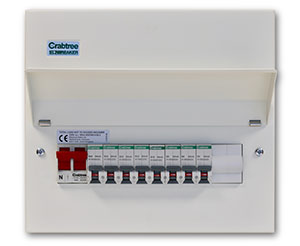explore the BusinessNet
Should RCBOs be considered compulsory for residential housing stock?
Story

As the latest revision of the IET Wiring Regulations (the 18th Edition) looms large, Dave Enefer of Crabtree asks whether RCBOs should be considered compulsory for all circuits in residential housing, especially given the evidence of the benefits of Miniature RCBOs to personal safety of occupiers & electrical operatives.
Public awareness of electrical faults and accidents has arguably never been higher. Even with all the advances in electrical safety technology and hardware there’s still room for improvement in take up of use of these technologies. Electrical dangers can come from many sources but when they do they shouldn’t bring with them added risk or inconvenience.
Why use Miniature RCBOs?
For any landlords, tenants, homeowners or those uninitiated in electrical products, RCBO stands for Residual Current Circuit Breakers with Overcurrent Protection. These devices are a combination of an RCD (Residual Current Device) and MCB (Miniature Circuit Breaker) in one.
In layman’s terms, an RCD detects Earth Leakage, i.e. current flowing where it shouldn’t, switching the circuit off where there is an Earth fault current. The RCD element of the RCBO is there to protect people.
In housing installations it’s not unusual to find that one or more RCDs are used alongside MCBs in the consumer unit, all grouped together protecting multiple circuits. What commonly happens when there is an earth fault on one circuit is the that a whole group of circuits, including healthy circuits, are switched off.
In these instances, using RCDs and MCBs in groups goes against specific aspects the IET’s 17th Edition Wiring Regulations. Specifically, Chapter 31 – Division of Installation, regulation 314.1, which requires every installation to be divided into circuits as necessary –
- To avoid danger in the event of a fault
- To facilitate safe inspection, testing and maintenance
- To take account of hazards that might arise from the failure of a single circuit e.g. lighting circuit
- To reduce the possibility of unwanted tripping of RCDs (not due to fault)
The above requirements cannot all be adequately provided for if groups of circuits are all connected to one or two RCDs in a consumer unit.
For instance, let’s take a scenario with an electrical shower, a common fixed electrical appliance in many homes. It wouldn’t be safe for the bathroom lighting circuit to be tripped off because of a single fault related only to the electric shower. The occupant would be plunged into darkness while in a wet and slippery environment. Both of these hazards being introduced following the reaction of an RCD to a single fault directly contravenes points 1 and 3 of avoiding danger.

Point 4 is more pertinent than ever these days as an increasing number of appliances place heavier demands upon circuits. Unwanted, or nuisance, tripping is far more likely to occur if we have one 30mA RCD protecting multiple circuits. As more and more electrical equipment is used within modern homes the likelihood of cumulative circuit protector currents (earth leakage likely to occur during normal operation) reaching a level sufficient to trip a 30mA device becomes a real risk.
Point 2, to facilitate safe inspection & testing is equally difficult to achieve. For instance is it safe if the lighting has to be off while the sockets are being tested. Clearly the most compliant way to accommodate Chapter 31 is to avoid grouping circuits on to one or even two RCDs and instead provide separate electrical protection by individual RCBOs for each circuit. Under these circumstances all healthy circuits will remain in service.
Go further by switching off line and neutral
Facilitating safe inspection and maintenance can be time-consuming for electricians, even with RCBOs, unless those RCBOs switch both Line & Neutral.
Typically with RCBO protected circuits, the outgoing cables and flying leads have to be disconnected and then reconnected when undertaking insulation resistance tests. This is very time consuming, but by using an RCBO with switched line and neutral it is not necessary to disconnect the circuit. Simply switch off the RCBO and the circuit is instantly isolated and ready for test.
For social housing landlords, having an obligation to regularly test large quantities of installations, this type of RCBO can save time, money and provide a safer environment while fully meeting requirements of the IET wiring regulations; in particular the need for maintaining power continuity under fault conditions. RCBOs that switch both line and neutral, either in the event of a fault or to facilitate maintenance, totally isolate the circuit in question. This provides the occupier with a safe environment while they await the emergency electrician, any fault is completely isolated and all other healthy circuits remain in working order.
Miniature means Miniature
Another area where developments in RCBO design can make a real difference is in their size. Miniature RCBOs are the same size as a miniature circuit breaker, one module wide and only 90mm tall. This gives installers almost 30% more wiring space within a consumer unit. When considered along with long standing Starbreaker ‘plug in’ technology this makes for a quicker, easier, safer installation.
As part of its commitment to improving user safety and installer convenience, Crabtree has now developed the Starbreaker Miniature RCBO. This is safer because it switches both live & neutral, and at no extra cost. Totally isolated circuits cater for Health & Safety at work for electrical operatives whether they are conducting periodic testing, fault finding, replacing damaged accessories, extending or adding to circuits. Totally isolating faults provides a safer living environment for occupiers at times when things go wrong and the emergency electrician is on the way.
